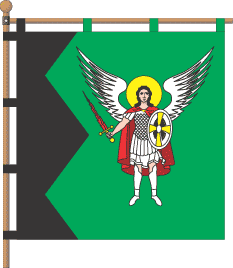 (1:1)
(1:1)image from the site of Ukrainian Heraldry

Last modified: 2011-03-18 by andrew weeks
Keywords: ternopil | nove selo |
Links: FOTW homepage |
search |
disclaimer and copyright |
write us |
mirrors
 (1:1)
(1:1)
image from the site of Ukrainian
Heraldry
See also:
From the site of Ukrainian
Heraldry:
"It was confirmed on April, 18th, 2006 by the decision #9 of
I village council session of V convocation in pursuance of
decision #230 of July, 18th, 2005 about public contest on own
symbols. Square panel is divided vertically in four fractures on
black from staff and free green fields in the ratio 1:2. In the
green field is Arhystratyg Michael in white armour and
red raincoat [cape], with a flaming sword in the right hand and
white shield in left. The authors are S.Tkachov and
V.Napytkin."
Dov Gutterman, 6 June 2006
In Orthodoxy "arhistratig" (from words
"arch-" and "strategy") is an Archangel -
"leader of Heaven`s Army".
"Raincoat" is a bad translating, of course. This cloth
is not for "rain only", this long cloth without sleeves
was used by knights.
Victor Lomantsov, 7 June 2006
Is this the same item usually described as a
"mantling" (meaning the knight's cloak as if cut to
pieces in battle) in English blazon on a coat of arms?
Colin Dobson, 7 June 2006
When I first read the description I thought that
"raincoat" was probably a mistranslation of
"surcoat" which was the long tunic-like garment worn by
armored knights but after seeing the graphic I realized that it
is actually a "cape" they meant to describe.
I have seen the garment customarily worn by a medieval knight
referred to as "cape" "cloak" or
"mantle", but not "mantling", except in the
heraldric context. In any case, in this representation the
garment appears more Roman than Medieval to me.
Ned Smith, 7 June 2006
On the July 2nd, 2006, in tne Nove Selo village (Pidvolochys'k
region, Ternopil's'ka oblast') was celebrated presentation of new
village coat of arms and gonfalon. Initiative of this action
belonged to village chairman V.Palyanytsa. There were many
partisipants - not only people from Nove Selo, but priests,
emblem authors S.Tkachov and V.Napytkin, visitors from neighbour
villages, regions and Ternopil', chairmans of many village
councils, chairman of Pidvolochys'k region council
B.Stadnits'kyi. Inhabitants of village were permitted to know
more about new emblem and remember glorious events of native
land. .
Ukrainian heraldry administraror, 3 July 2006
tp-ns.gif)
image from the site of Ukrainian
Heraldry
From the site of Ukrainian
Heraldry:
"It was confirmed in April, 18th, 2006 by the decision #9 of
I village council session of V convocation in pursuance of
decision #230 of July, 18th, 2005 about public contest on own
symbols. Vert with sable base, broken in four fractures;
Arhystratyg Michael in argent armour and gules raincoat, with a
flaming sword in the right hand and argent shield in left. The
shield enframed by or cartouche and crowned by or village crown.
The authors are S.Tkachov and V.Napytkin.
Four fractures remind of the first settlement - Vegeriv Okip
("trenches"), whose inhabitants have based Nove Selo,
and also emblem "Abdank" of Bohdan Khmel'nyts'kyi,
because a lot of the village inhabitants took part in his revolt
against the Poles."
Dov Gutterman, 6 June 2006
From the site of Ukrainian
Heraldry:
"According to the legends, on northeast from modern village
was an old settlement Vegeriv Okip, which was destroed by the
Tatars in the second half of XV century. The survived inhabitants
of Vegeriv Okip in the beginning of the first quarter of XV
century have moved on a Mlyns'kyi Potik river coast and based new
village ("nove selo").
The first historical mention refers to July, 9th, 1463, when the
Nove Selo became the property of prince Zbaraz'kyi Vasyl'.
Inhabitants served in the Bohdan Khmel'nyts'ky army, took part in
storm of Zbaraz'kyi castle. After Andrusiv armistice in 1667,
Nove Selo remained in the Poland jurisdiction. In the end of XVII
century it became the property of gentlemen Yordans, who owned it
more than 100 years. During of XVI century and first half of
XVII century village was attacked and devastated by Tatars
eighteen times. In 1772 Nove Selo has departed to Austria.
According to Yosyfins'ka census of 1786 in the Nove Selo were 47
village houses, gentleman house, tavern, distillery. There
existed church elementary school."
Dov Gutterman, 6 June 2006